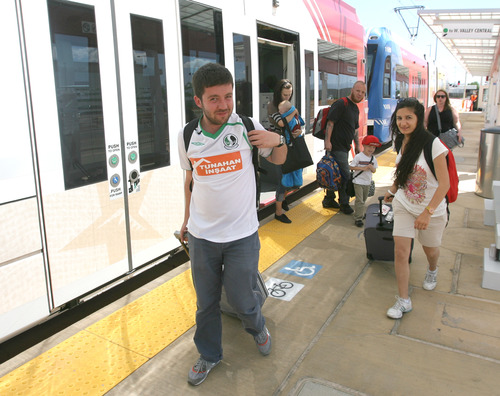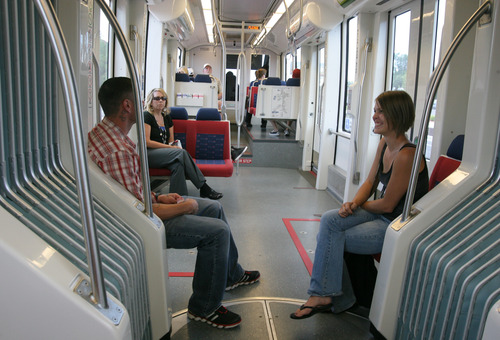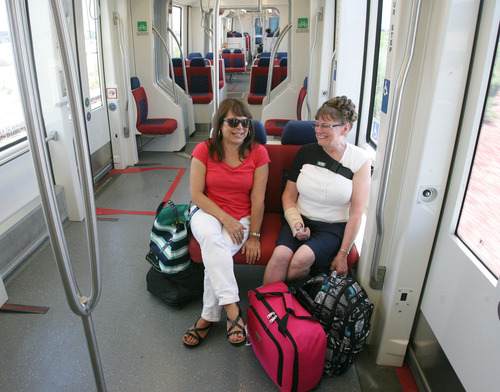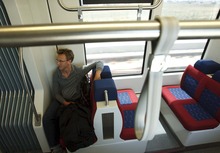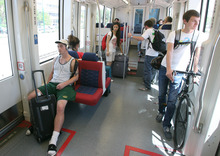This is an archived article that was published on sltrib.com in 2013, and information in the article may be outdated. It is provided only for personal research purposes and may not be reprinted.
After adding $1.2 billion worth of new rail lines in the past year, the Utah Transit Authority projected that its overall ridership would be growing.
Instead, it dropped — or remained flat, depending on which data or official one chooses to believe most. Either way, it is causing some heartburn at UTA, although officials say they should be fine in the long run as they take steps to improve service.
The number of UTA passengers in the first four months of this year — compared to the first four months of 2012 — decreased by 12,840, a 0.09 percent dip out of a total 14.7 million passengers, according to data provided to The Salt Lake Tribune. That includes not only riders on buses and trains, but also on paratransit and rideshare van service.
Ridership on just trains and buses was up slightly, by 5,418, a tiny 0.04 percent increase out of a total ridership on them of 13.9 million.
"Ridership is about the same as last year," said Jerry Benson, UTA chief operating officer. "I don't think I would say it is dropping."
But when UTA Board Chairman Greg Hughes, who is also a state legislator, heard such numbers at a committee meeting this week, he said, "If we stayed the same, but added new rail lines, it's like we decreased."
UTA opened an $850 million FrontRunner commuter-rail extension from Salt Lake to Provo in December and a $350 million TRAX line to Salt Lake City International Airport in April. Data included only one month of operation by the new TRAX line — but passenger decreases were actually worse that month than in the overall period. UTA also hiked fares in April.
—
Bus losses • The numbers had UTA Board members asking why the agency is not hitting projected ridership and whether it may have made a mistake by cutting bus service to push people to the new rail lines.
As bus service was cut to fund new rail lines, bus ridership dropped by 631,139 in the period. Meanwhile, FrontRunner ridership jumped by 620,450. TRAX ridership grew by 16,287 over the entire period (but fell by 18,829 in just April as the airport line opened).
Benson said UTA found — by tracking those who use electronic passes — that about 30 percent of the former passengers who used express buses between Utah and Salt Lake counties never made the switch to FrontRunner, and are now apparently driving instead to save time or money.
Meanwhile, he said the new FrontRunner did pick up many new passengers who did not use transit previously — as shown by new passes purchased by the University of Utah, the LDS Church and Adobe.
—
Rider concerns • Scott Taylor is one of the riders that UTA lost. He used to ride an express bus from near his Cedar Hills home in Utah County directly to the front door of his job at the LDS Church Office Building in downtown Salt Lake City.
"It took about an hour," he says. UTA eliminated that express bus. He now would need to walk farther to a neighborhood bus, take it to FrontRunner, transfer in Salt Lake City to the airport TRAX, and walk farther than before to work. "It would take about two hours. So I dropped out of UTA."
He joined a private van pool that takes about 45 minutes. It costs $70 a month, compared to the $15 a month he used to pay for an employer-subsidized UTA pass.
Taylor said he and numerous fellow riders petitioned UTA to save the express bus, and talked to officials. "They just said that FrontRunner wouldn't be for everyone, and if it's not right for you, to look for something else. They didn't seem to care," he said. "I'm not surprised ridership is down."
He said additional UTA changes since the Provo FrontRunner line opened actually made things worse for his co-workers at LDS headquarters.
"At first there was a shuttle bus from the FrontRunner station on North Temple," he said. "But they quit offering that when the airport TRAX opened. The connections to it take longer, and it drops people farther away."
—
Fares too high? • Critics say flat ridership, even with the new rail lines, should also make UTA look at its fares — which are among the highest in the nation.
"There was a tax fare increase" in the period as ridership remained flat or dropped, noted Bill Tibbitts, associate director of the Crossroads Urban Center, which is among groups that help the poor that asked UTA last year to avoid more fare hikes.
"I think they need to find the point where fares would bring in the most revenue. Sometimes you get there by lowering them to increase ridership," he said. Tibbitts noted that when UTA and Zions Bank offered 2,500 free weeklong transit passes this week, they disappeared in a day — a sign people will move to transit if fares are free or low.
UTA last year decreased its fares on buses to Park City and saw their ridership rise by 1,000 a month — even as it reduced the number of trips offered.
—
Wise switch? • UTA Board member H. David Burton noted that the tax subsidy per rider is much higher for commuter rail than for bus — about $8.47 vs. $4.25 per rider. So he asked in a committee meeting if UTA made a mistake pushing riders to a transportation mode that may be more expensive per trip.
Benson responded that focusing on rail is a better long-term strategy grounded in more frequent and steady service.
"The [express] bus market we had in the past served really just a niche market of commuters. They loved those buses, and they filled them up every day. What we have now with FrontRunner is a connection all day long to the whole network that serves the whole community."
He said that provides more and better connections for more people all day long, "and we're going to be able to get to a place we never could get to with just the bus service."
"Thou almost persuadeth me," said Burton, the former presiding bishop of the LDS Church, echoing what King Agrippa told the ancient apostle Paul about almost being converted to Christianity.
UTA General Manager Michael Allegra added that if UTA looks at subsidy per rider mile traveled — not just per rider — FrontRunner commuter rail outperforms TRAX and bus because of the long distances it travels.
—
Too many changes? • Benson said a major factor holding back ridership is the continual schedule and service changes it has made in recent years as it added three new TRAX lines and the FrontRunner extension.
"Even if it is just a schedule change or a minor change in routing," he added, "that means customers have to readjust what they do and change their travel patterns," and some drop out with every change.
As UTA swapped trains for buses, it also meant that "people who may have had a bus that was in their neighborhood now either have to transfer on a bus or drive to a park-and-ride [lot]. It's going to take time for people to adjust to the system as it is configured now. I think we will see that over time."
Benson said UTA is now nearing the end of years of major construction, so the agency is coming to a point "where we can really refine the system and make connections work better for people." But it plans to open a TRAX line to Draper in August, and the new Sugar House streetcar line in December — and will have more schedule changes then.
A UTA committee this week also recommended adding $4 million to the current budget — coming from higher-than-expected sales tax revenues — to save some bus service that would otherwise disappear, and to make some other bus service more frequent. The full board will consider it later this month.
Benson said such steps and greater system capacity from the new rail lines still make UTA's future look bright. "Long term, I think we've got a terrific network. It's a matter of making all of the detail work and make that last mile or the connection work for folks."
He said a challenge for UTA will be to show customers it lost that it has improved the system over time — and coax them to return.


